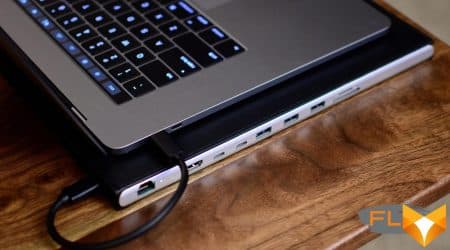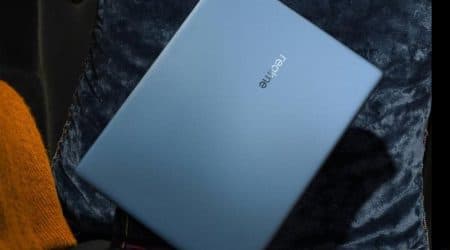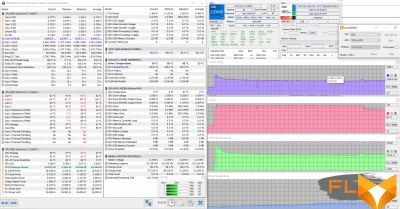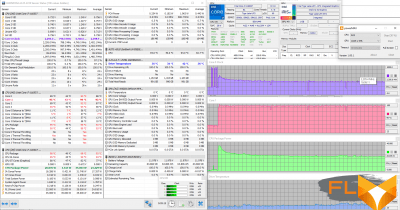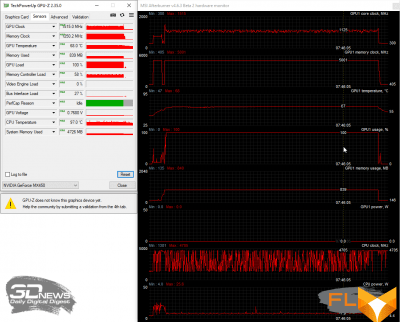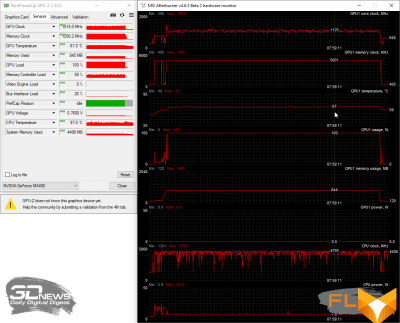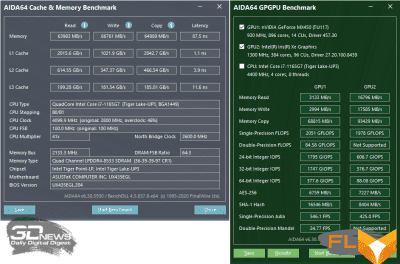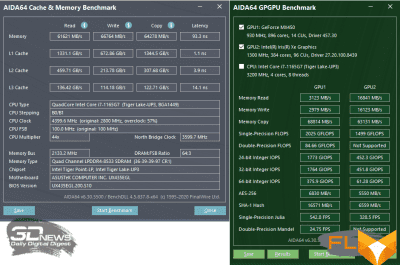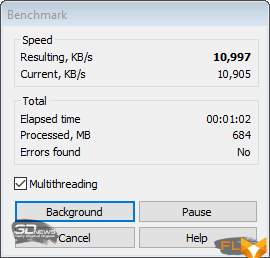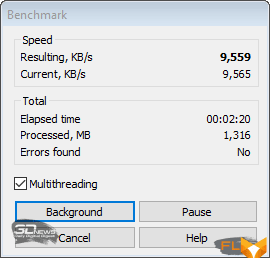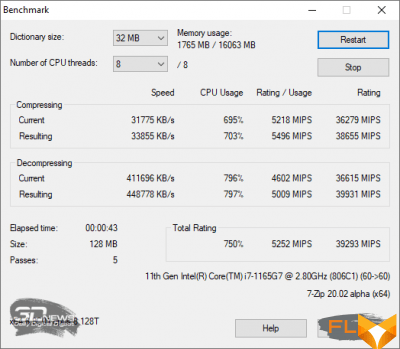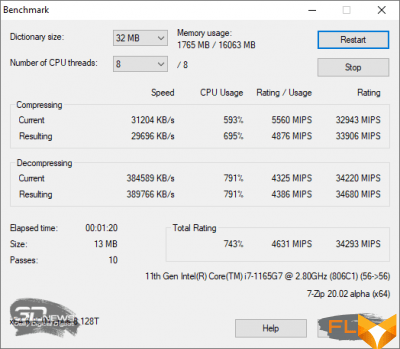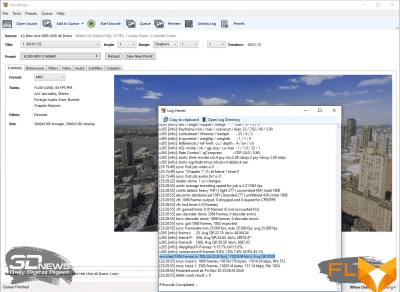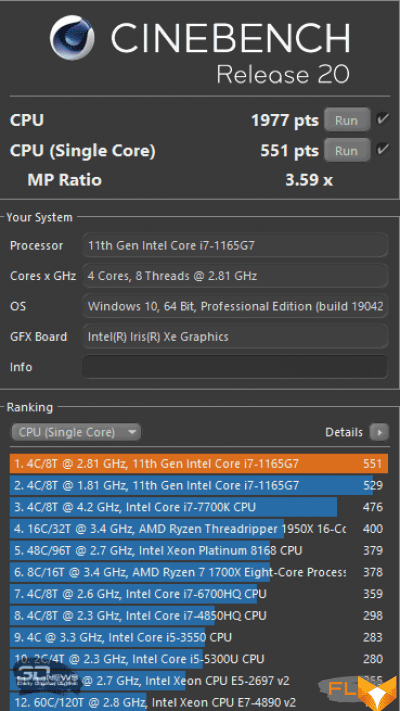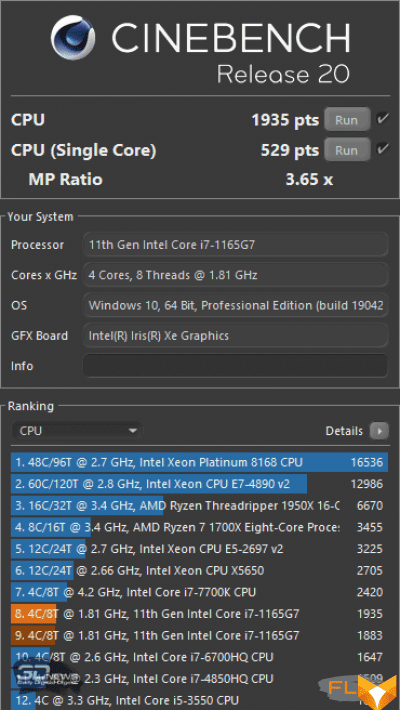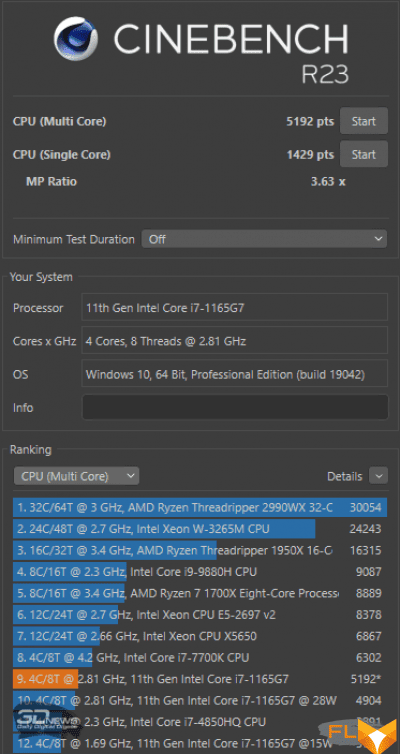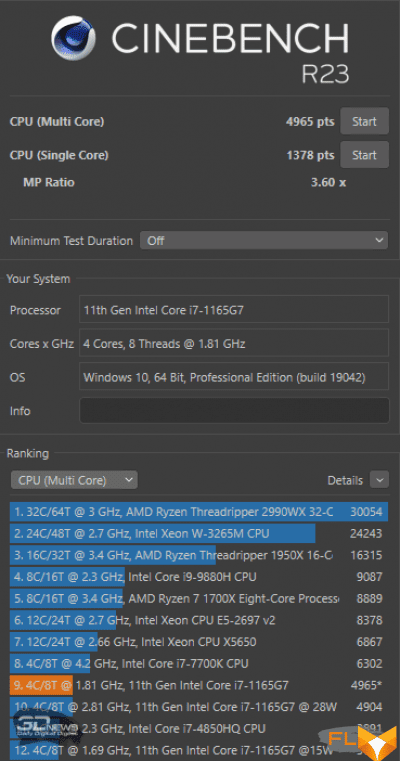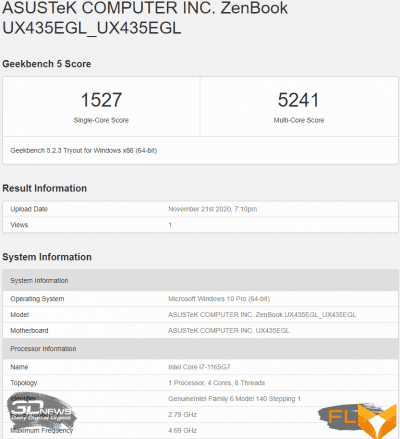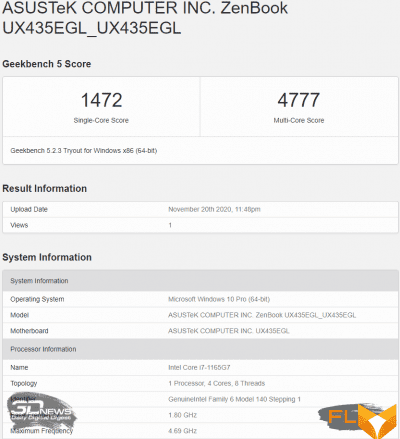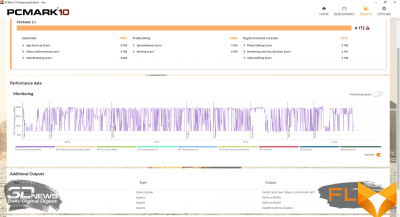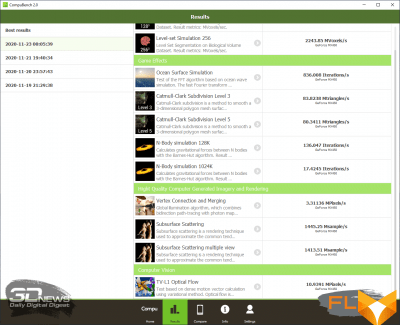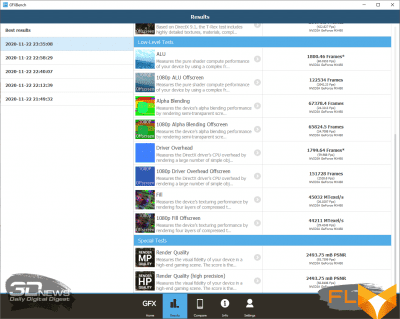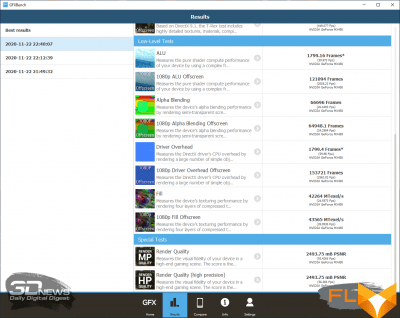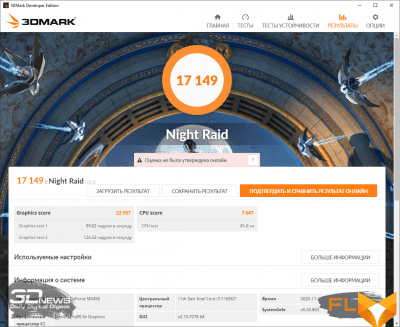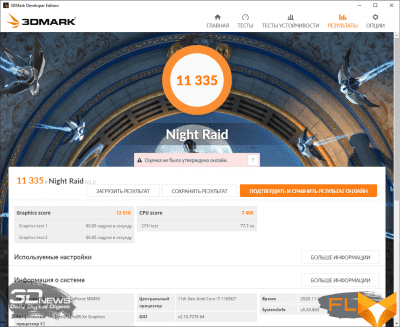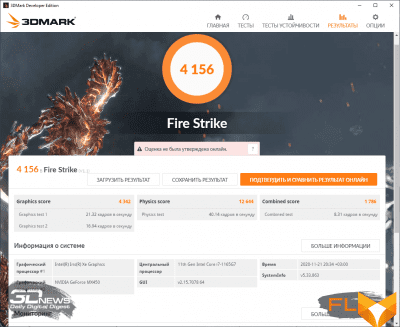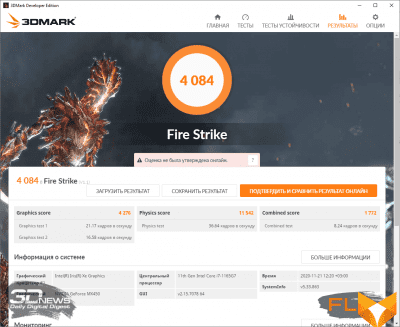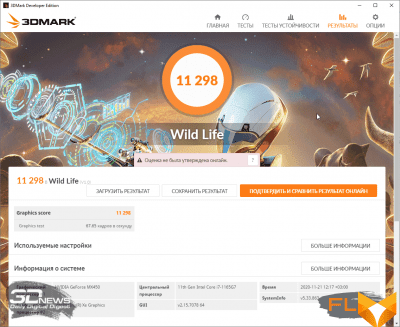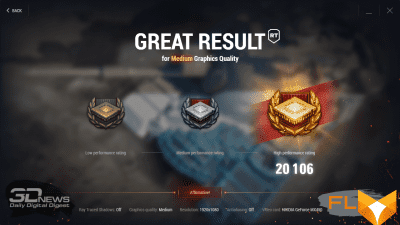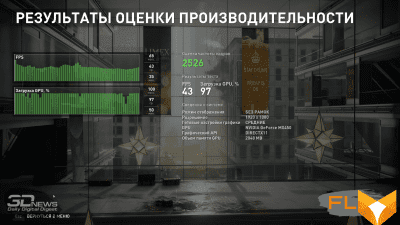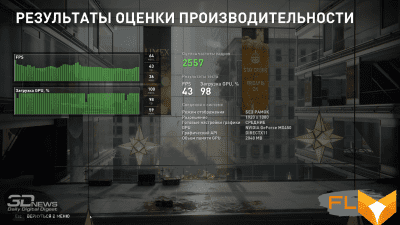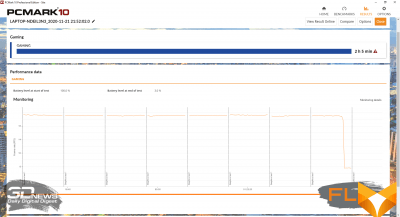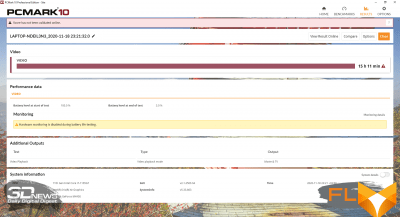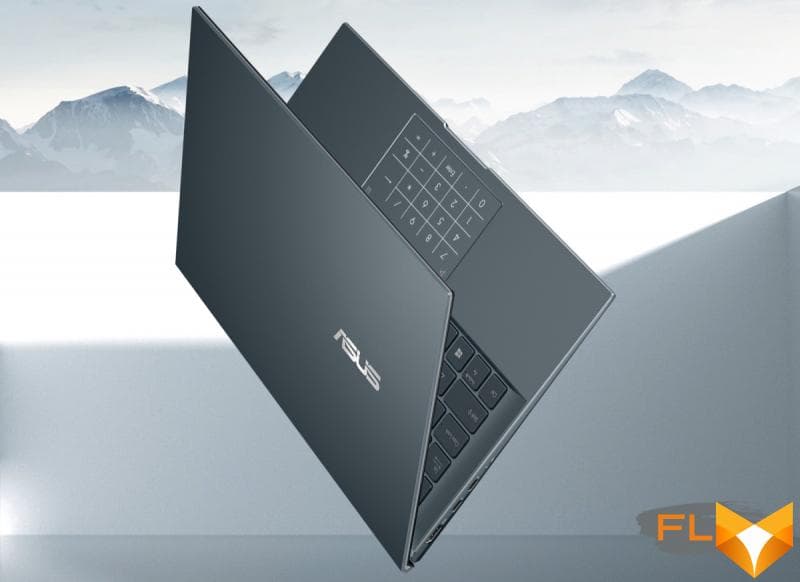


The fall of 2020 will be remembered by the whole world not only for the tense situation with the spread of a new coronavirus infection, but also, perhaps, as the most generous period for Hi-Tech novelties in the last five years for sure. Judge for yourself – in just a couple of months, NVIDIA GeForce RTX 30XX and AMD Radeon RX 6800 (XT) video cards, AMD Ryzen 9 59XX processors, Xbox Series X and Sony PlayStation 5 game consoles, as well as the twelfth version of the Apple iPhone were released. And these are only the most significant events, without taking into account a series of new games and announced technologies.
Of course, against this background, announcements of other products are easy to get lost, but there is something to see among them. In particular, ASUS works like an automaton on the monthly announcement of new laptop models, the reason for which was the August announcement of Intel Tiger Lake-U processors with an integrated Intel Xe graphics core. Most recently, we got acquainted with the premium ultrabook model ASUS ZenBook Flip S UX371EA, and today we will study and test the more affordable model ASUS ZenBook 14 Ultralight UX435EGL – a compact and lightweight, but at the same time sufficiently productive ultrabook with a discrete NVIDIA graphics card.
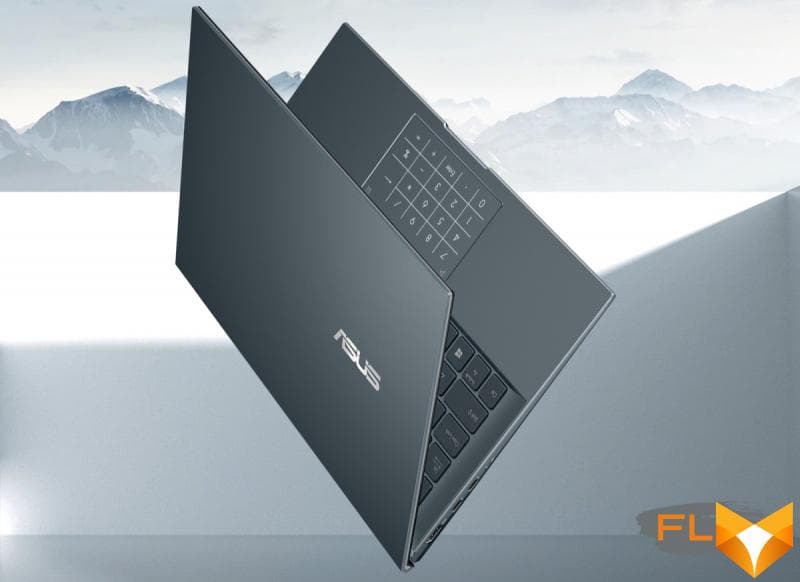
⇡#Packaging
ASUS ZenBook 14 Ultralight UX435EGL comes in a small cardboard box with a carrying handle. The box is laconic – no bright inserts and stickers, only the name of the ultrabook series and the processor manufacturer.
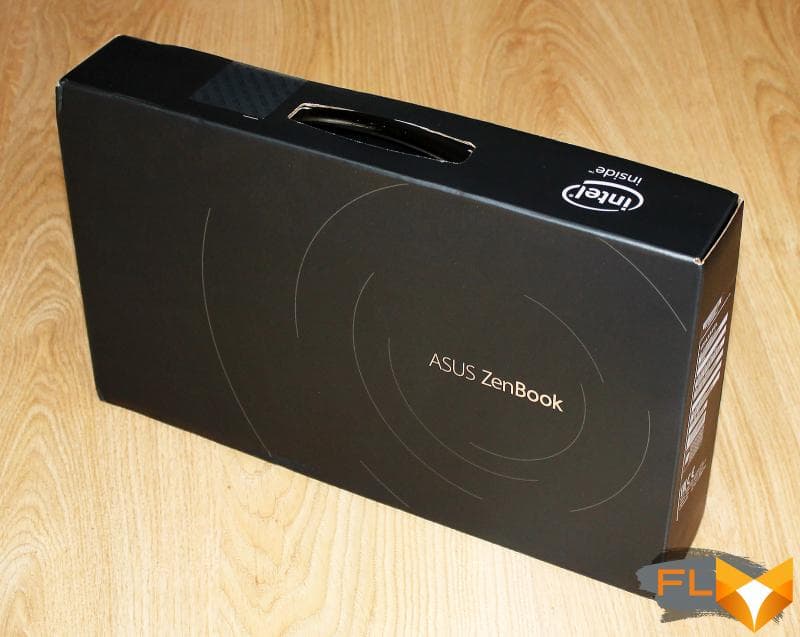
At the end of the box, you can find a sticker with serial numbers and an indication of the ultrabook model. It has no configuration.
We have a pre-release ultrabook sample, so it only comes with a power adapter with an American standard plug and an adapter.

Serial versions, of course, will have a complete set and will certainly get interesting bonuses, as is most often the case with ASUS in this class of ultrabooks.
ASUS ZenBook 14 Ultralight UX435EGL is manufactured in China and comes with a two-year warranty. As for the cost, they will ask for $ 1,300 for the minimum configuration, and the price for top versions is not yet known.
⇡#Specifications
| ASUS ZenBook 14 Ultralight UX435EGL | ||
| Processor | Intel Core i7-1165G7 (10 nm SuperFin, 4 cores/8 threads, 1.2-4.7 GHz, 12 MB L3 cache, TDP 12-28 W) Options: – Intel Core i5-1135G7 |
|
| Chipset | Intel Tiger Lake | |
| RAM | 2 × 8 GB LPDDR4X 4266 MHz (dual channel, 36-39-39-90 CR1) Options: – 2 x 4 GB LPDDR4X 4266 MHz |
|
| Video Subsystem | Integrated into the Intel Iris Xe Graphics processor; NVIDIA GeForce MX450 2GB/64bit |
|
| Drives | NVMe 3.0 x4 M.2 SSD Intel P660 (SSDPEKNW010T8) 1TB Options: – 256GB SSD; – 512GB SSD; – 32 GB Intel Optane H10 + 512 GB/1 TB SSD |
|
| Display | 14″ NanoEdge Display, IPS Full HD (1920 × 1080), 60Hz, 100% sRGB, 178° | |
| Sound subsystem | Two stereo speakers; Realtek audio codec; certification by Harman Kardon specialists; microphone array with Cortana voice control |
|
| Optical Drive | None | |
| Cart Reader | MicroSD | |
| Network Interfaces | Cable network | None |
| Wireless | Intel Wi-Fi 6 AX201D2W 802.11ax, MIMO 2×2, 2.5GHz and 5.0GHz (160MHz) | |
| Bluetooth | Bluetooth 5.0 | |
| NFC | None | |
| Interfaces and Ports | USB 2.0 | None |
| USB 3.2 Gen1 | 1 (Type-A, up to 5 Gbps) | |
| USB 3.2 Gen2 | 2 (Type-C, Thunderbolt 4, up to 40Gbps) | |
| HDMI 2.0b | Yes | |
| VGA | None | |
| DisplayPort 1.4 | None | |
| RJ-45 | None | |
| Microphone input | Yes (combined) | |
| Headphone output | Yes (combined) | |
| Input Devices | Keyboard | Membrane with backlight and function keys, key travel ~1.4 mm |
| Touchpad | NumberPad 2.0, two-button, 105 × 62 mm, gesture support | |
| VoIP | Webcam | HD and IR with Windows Hello |
| Microphone | Yes | |
| Battery | 63 Wh, 3 cells, lithium polymer | |
| Power Adapter | AD2129320 (65W, 20.0V, 3.25A), 225g with 1.95m cable | |
| Dimensions | 319.0 × 202.5 × 17.5 (16.0) mm | |
| Weight without power adapter: declared/measured | 995 / 967g | |
| Laptop color | Pine Grey | |
| Other Features | MyASUS; image optimization (Splendid); video optimization (Tru2Life); Wi-Fi roaming optimization; AppDeals service; Hotkeys; safe recharging |
|
| Operating System | Windows 10 Pro/Home | |
| Warranty | 2 years | |
| Retail value | From $1300 | |
⇡#Design and ergonomics body
Ultrabook ASUS ZenBook 14 Ultralight UX435EGL is available in a single color, which ASUS calls “grey pine” (Pine Grey), and looks quite modern and stylish. The plastic panels of the ultrabook case have a light glossy tint, but at the same time their surface is non-staining – there are practically no fingerprints left on it.
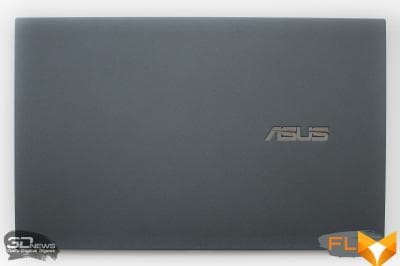 |
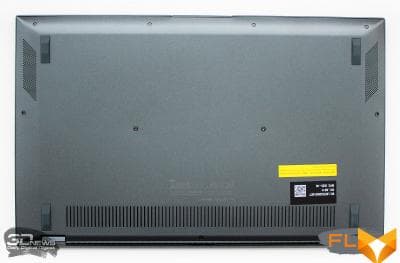 |
When looking at the panels at an angle, it seems that they are covered with the smallest crumb, which shimmers in the light. In combination with the chrome ASUS logo, it looks very nice.
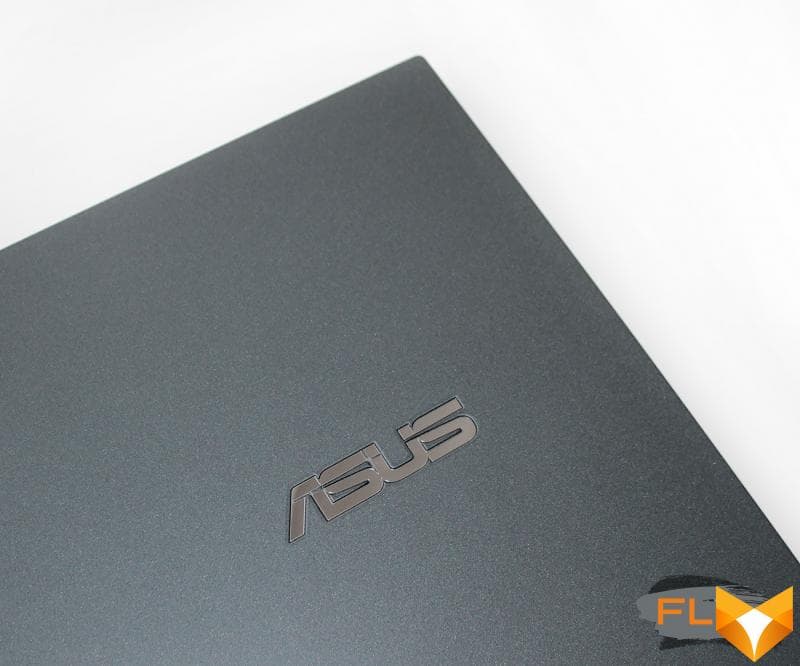
Below, on the basis of the body of the ultrabook, you can find the model name, country of manufacture and electrical characteristics of the power adapter.
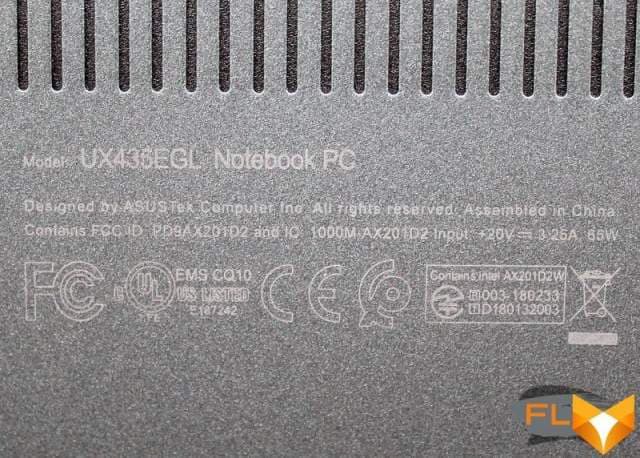
To prevent the case from slipping, there are four rubber feet on the bottom panel, resembling a trapezium of the lowest possible height.
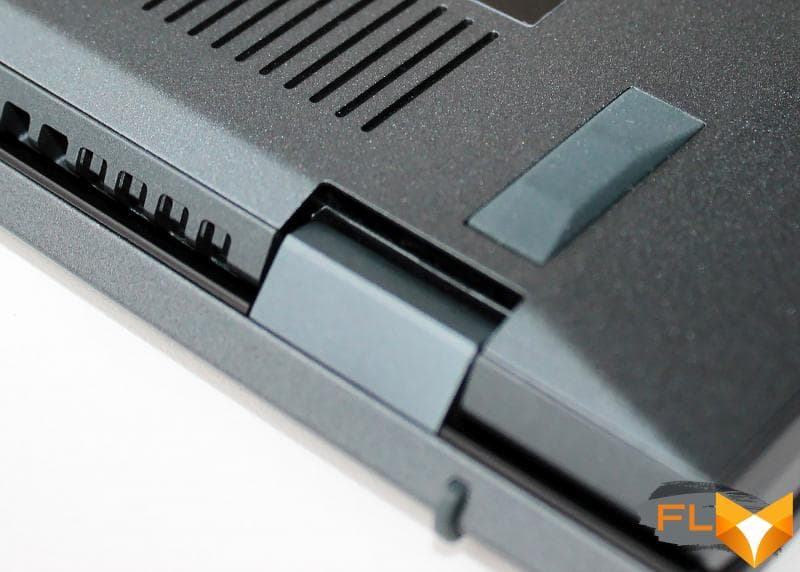
The ultrabook is compact and lightweight: its dimensions are 319.0 × 202.5 × 17.5 mm (front thickness 16.0 mm), and it weighs less than one kilogram (967 grams to be exact). It is more like a thick magazine than a compact computer – it is easy and convenient to carry it with you.
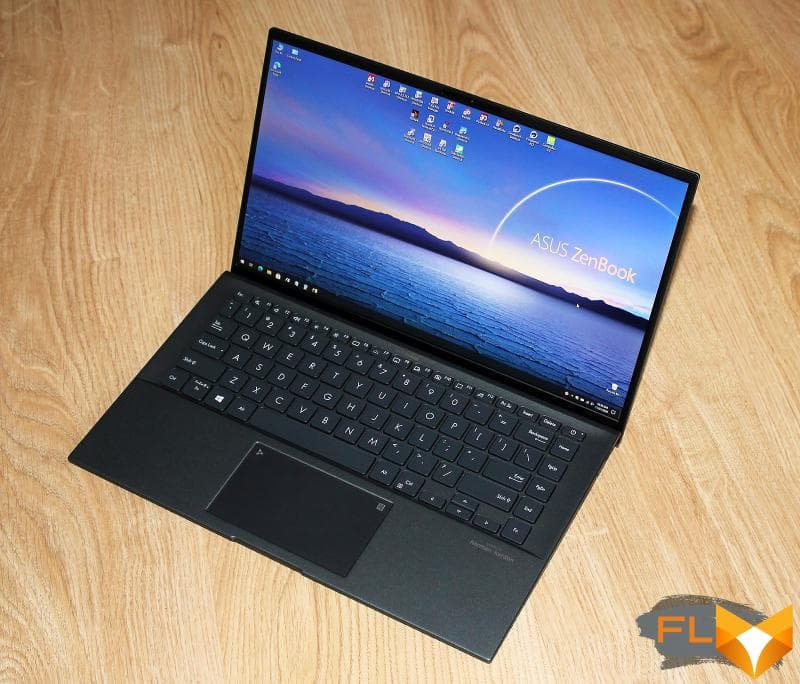
The panel with the display can be opened with one hand – you do not need to hold the base – and is fixed in any position.
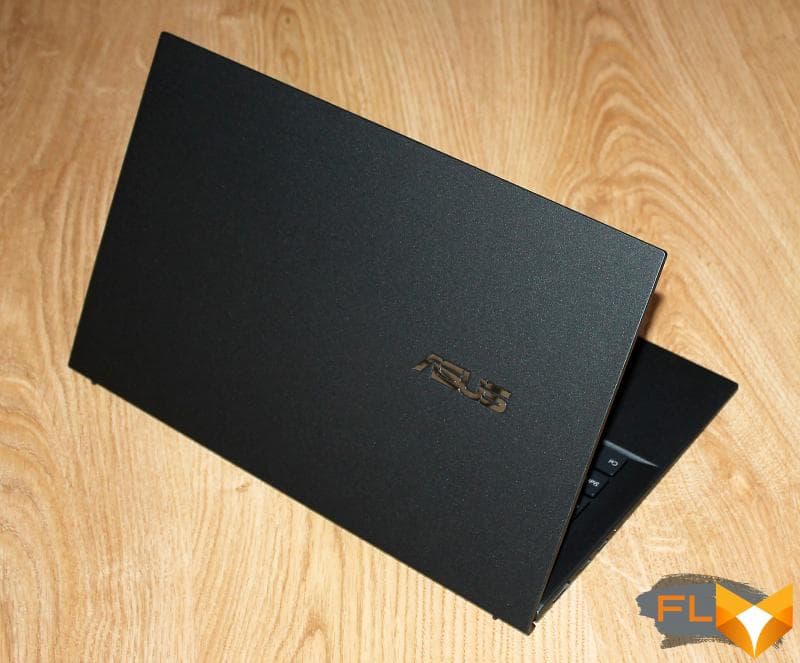
The display opening angle is 135 degrees.
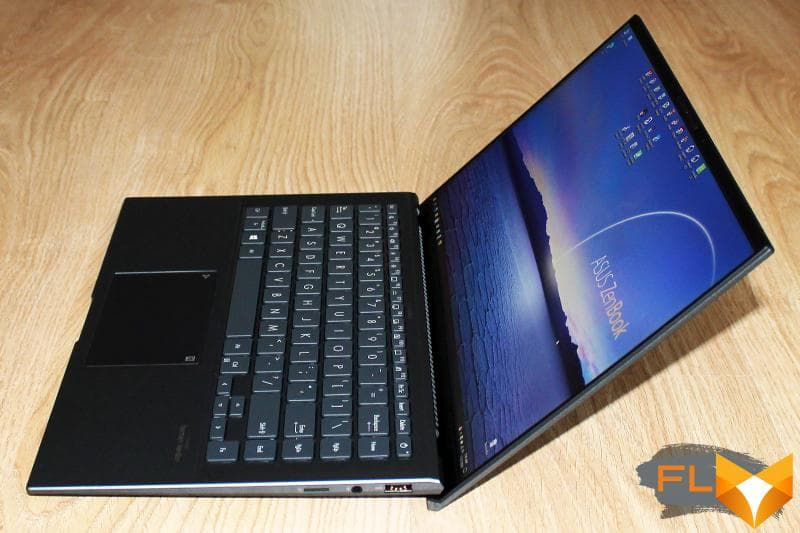
In the open position, the display raises the base of the ultrabook by 3 degrees.
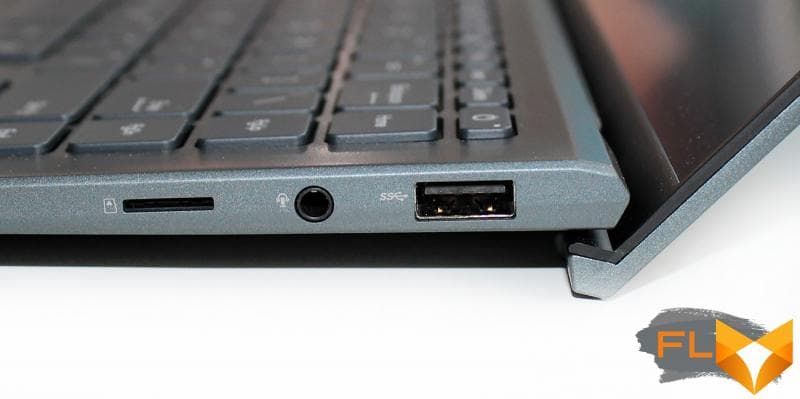
A well-known feature of ASUS Ultrabooks is the exclusive ErgoLift screen hinge, which improves hand comfort when typing, improves the cooling efficiency of internal components and improves sound quality.
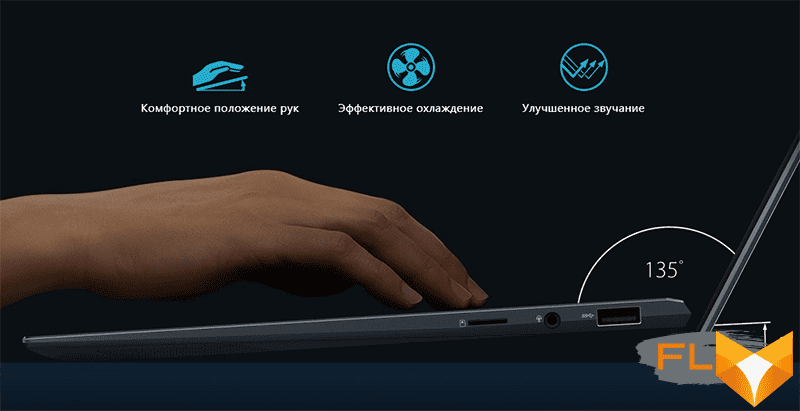
You might think that the end of the cover with such constant openings can be scratched, but ASUS prudently equipped it with two plastic stops.
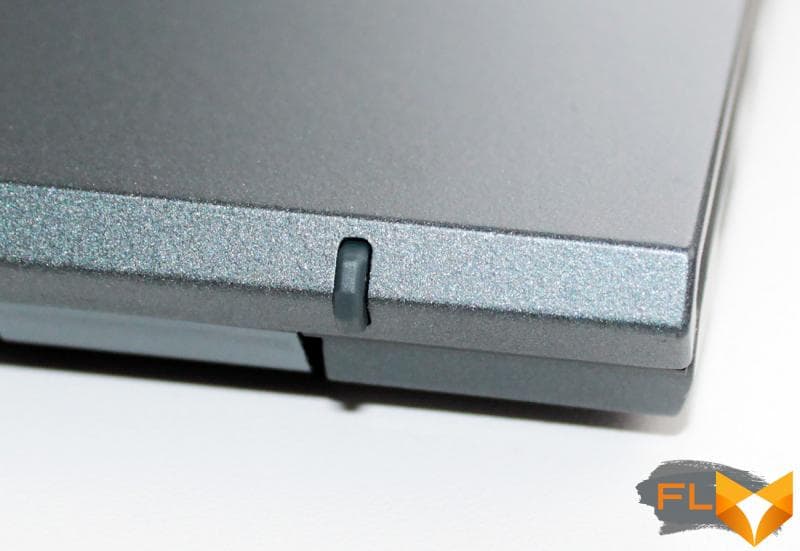
All ports and connectors are displayed on the side ends of the ultrabook.
 |
 |
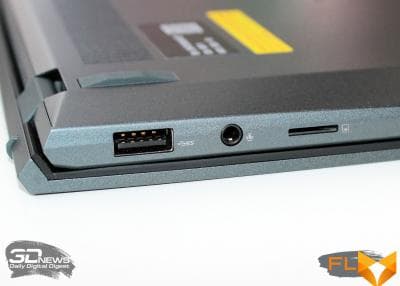 |
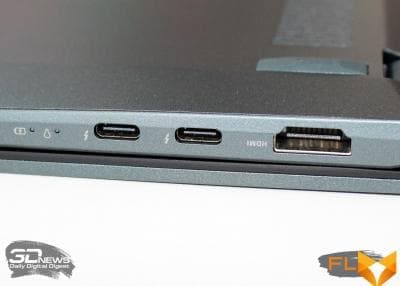 |
ASUS ZenBook 14 Ultralight UX435EGLmicroSD card reader, headphone/microphone combo jack, one USB 3.2 Gen1 Type-A (5 Gb/s), HDMI video output, two USB 3.2 Gen2 Type-C ports with Thunderbolt 4 support (up to 40 Gb/s) with Power Delivery and indicators.

Note that the set of ports here is more successful than that of the ASUS ZenBook Flip S UX371EA – there is both a card reader and a mini-jack.
⇡#Input Devices
The keyboard of the ASUS ZenBook 14 Ultralight UX435EGL is membrane type, with a key travel of 1.4 mm.

Since we have a pre-release version of the ultrabook on tests, there is no Russian layout on it. At the same time, English is applied in white characters on a gray-green background, and they are read well.
The dimensions of the main keys are 15.5 × 14.5 mm, and the function keys are 13.0 × 7.0 mm. But there is also a problem with the reduced arrow keys that constantly migrates from one ZenBook to another: here they have dimensions of 15.5 by 7.0 mm – it is very inconvenient for an adult to use them. The ultrabook power button located next to the Delete button does not work when accidentally pressed.
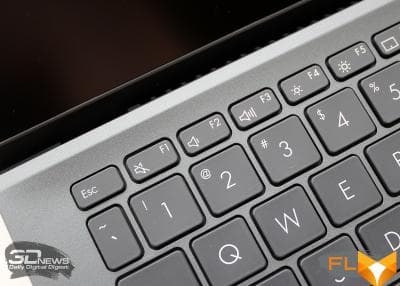 |
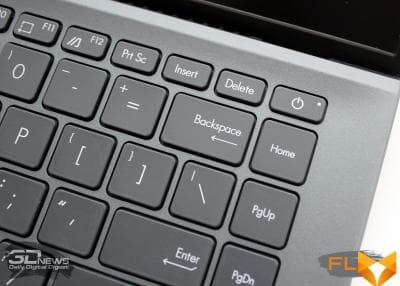 |
 |
 |
The keyboard is equipped with a three-level backlight, the uniformity of which ASUS specialists would do well to work on. In our sample, the spacebar was especially distinguished.
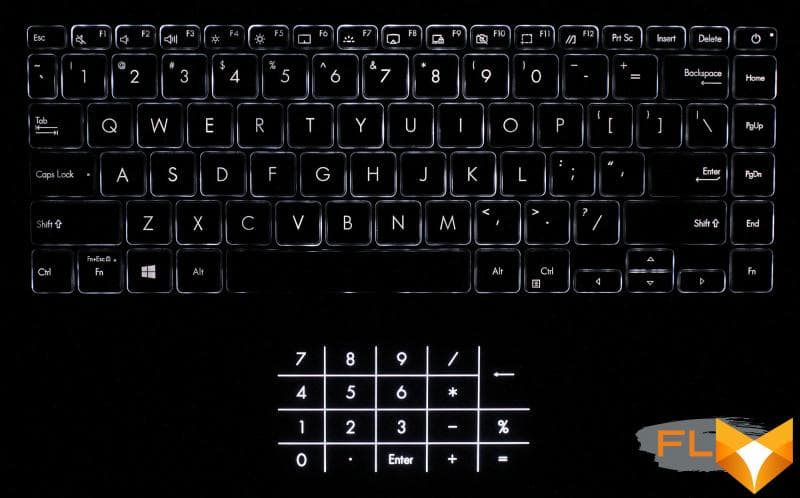
When typing, the keyboard does not make any noise, so working on an ultrabook late at night will definitely not interfere with your household.
Instead of the usual touchpad, the ultrabook is equipped with a 105 × 62 mm NumberPad 2.0 device, which turns into a numeric keypad by pressing a single button in the upper right corner.
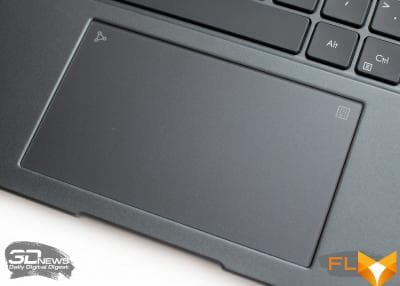 |
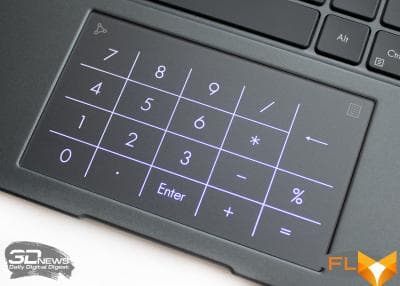 |
It works without any complaints. We add that there are versions of ASUS ZenBook 14 Ultralight UX435 with a ScreenPad 2.0 display instead of a touchpad, which makes this ultrabook even more functional and versatile in use.
An HD camera, an IR camera and an array of optimized microphones (supporting echo cancellation and intelligent noise reduction) are built into the top edge of the ultrabook’s display.
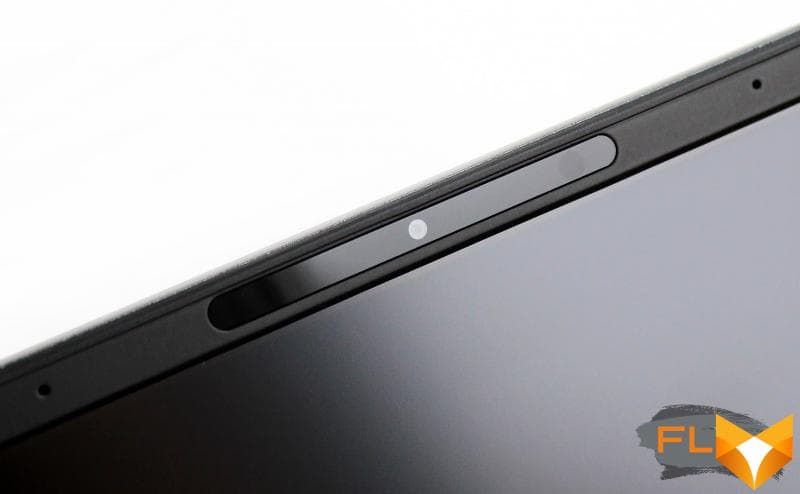
Note that the build quality of the ultrabook is at the highest level. Due to the fact that the panels are thin, they flex, but there are no squeaks or clicks at these moments. Everything is assembled very neatly and reliably, it is pleasant to use the ultrabook both from a visual and tactile point of view.
⇡#Display
Our version of the ASUS ZenBook 14 Ultralight UX435EGL features a 14-inch NanoEdge IPS thin-bezel, FHD (1920×1080) resolution at 60Hz. Claimed color gamut at 100% sRGB and viewing angles of 178 °.
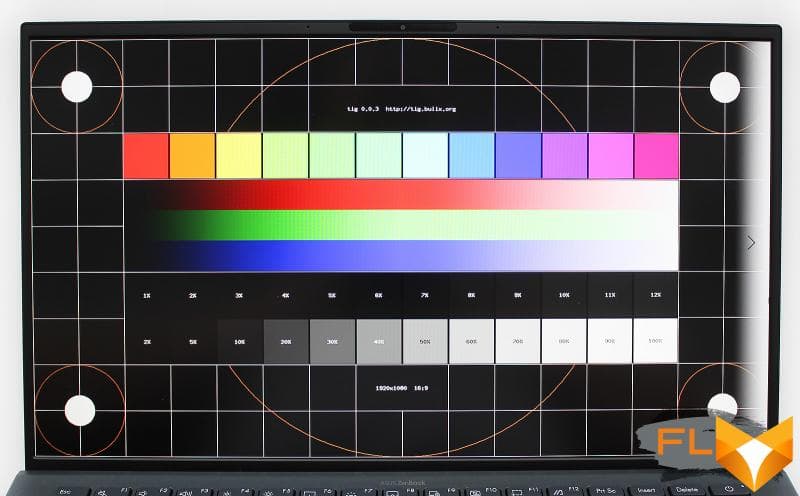
The surface of the matrix is matte, its marking is AUOA48F (manufactured by AU Optronics).
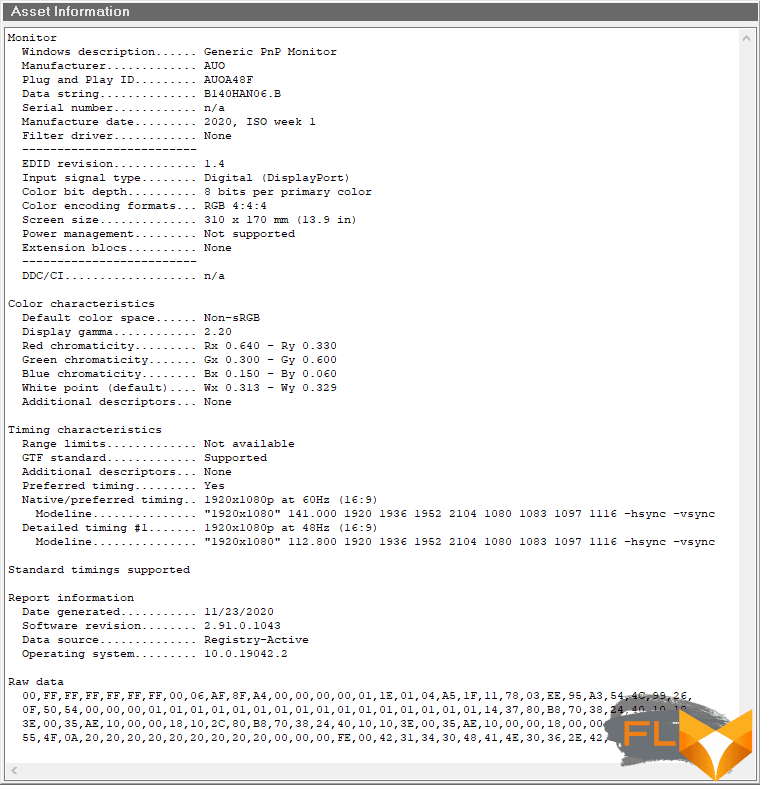
We tested the ultrabook display with the X-Rite i1 Display Pro calibrator and Argyll CMS software with the DispcalGUI GUI. All measurements were taken prior to display calibration. Let’s look at the results.
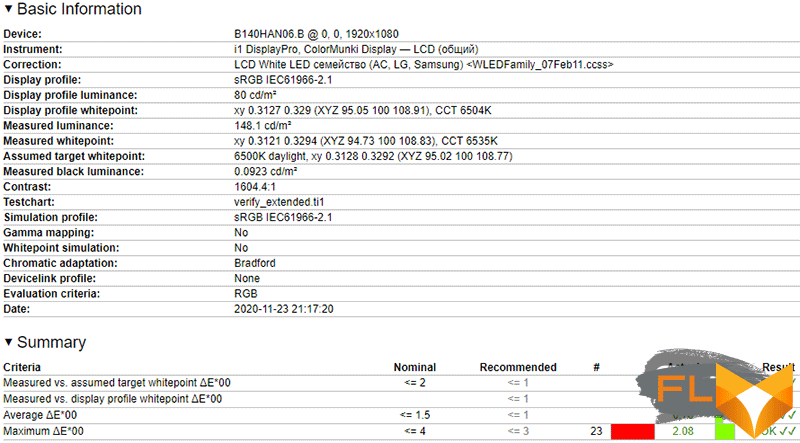
With a color temperature close to the reference value of 6500 K, we can assume that the screen of the ASUS ZenBook 14 Ultralight UX435EGL is already quite well calibrated at the factory.
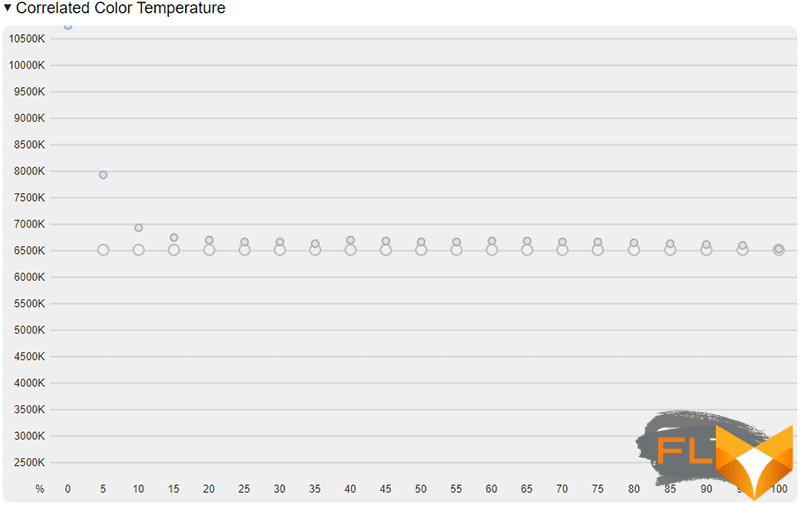
The gamma curve also runs close to the reference.
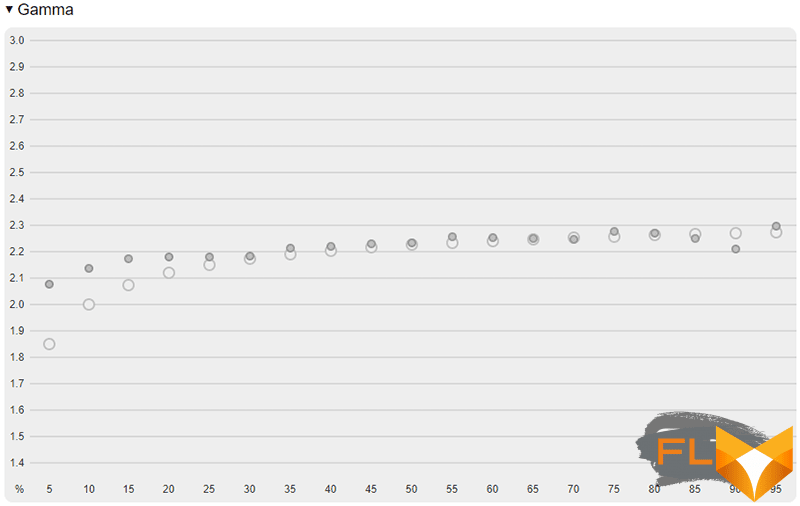
The same can be said about the color balance in the gray gradient.
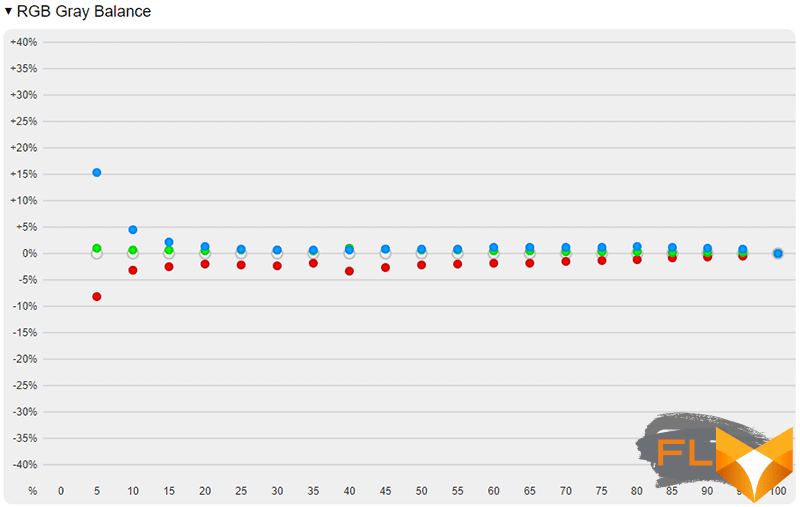
As a result, we can summarize that the display of the ASUS ZenBook 14 Ultralight UX435EGL ultrabook is almost perfectly tuned and does not require calibration.
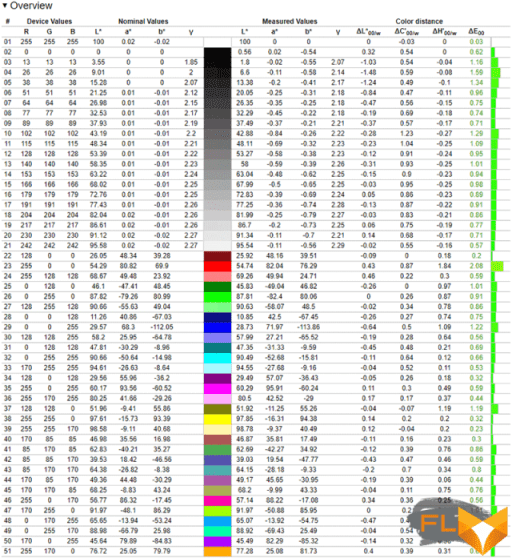
In principle, this was confirmed by the results of the same calibration.
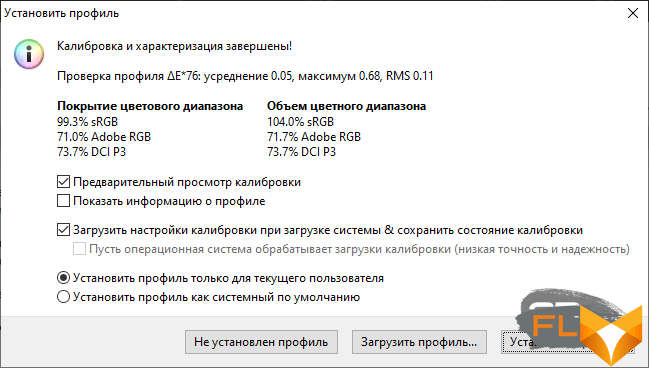
According to the results of measurements, the maximum brightness of the display was 394 cd/m2, and the minimum was 20 cd/m2. We will show the entire range of brightness measurement further on the graph with a step of 10%.
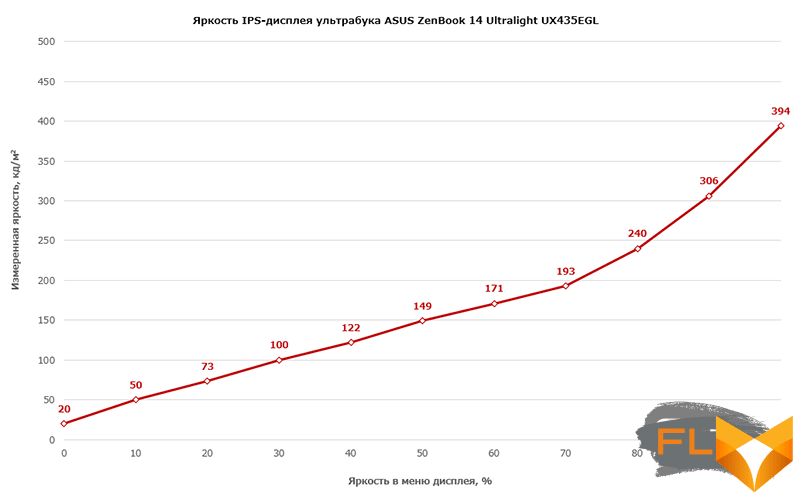
Subjectively comfortable for working with an ultrabook indoors is the brightness level of 45-47%. If ASUS ZenBook 14 Ultralight UX435EGL is used outdoors in daylight, then the brightness will have to be increased to 60%. Unfortunately, we didn’t have a chance to check the display in direct sunlight in gloomy autumn weather.
The uniformity of the backlight of the display, measured at the set brightness level of 200 cd/m2, raises questions only in one zone from the left edge, but again, this is impossible to notice without special devices.
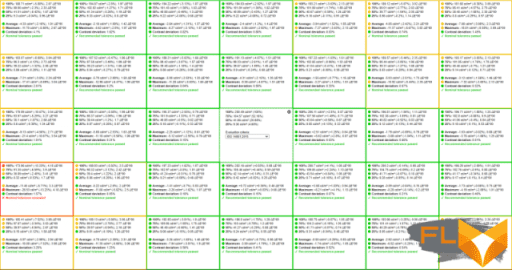
In general, we can summarize that the display of the ASUS ZenBook 14 Ultralight UX435EGL is of very good quality and with accurate factory calibration.
⇡#Internal device and accessories
Unfortunately, this time we failed to get to a visual inspection of the internal layout of the ASUS ZenBook 14 Ultralight UX435EGL ultrabook – the latches on the case turned out to be too tight, and it was inappropriate to apply a higher force to the test sample for obvious reasons. Therefore, you will have to study the components using software and diagnostic software. Let’s start with AIDA64 Extreme.
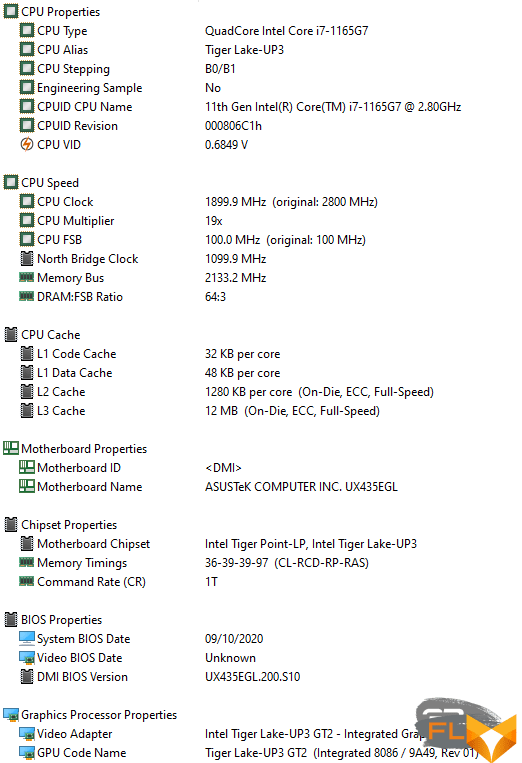
The ZenBook 14 Ultralight UX435EGL hardware is based on an Intel chipset motherboard with a BIOS version as of October 9, 2020.
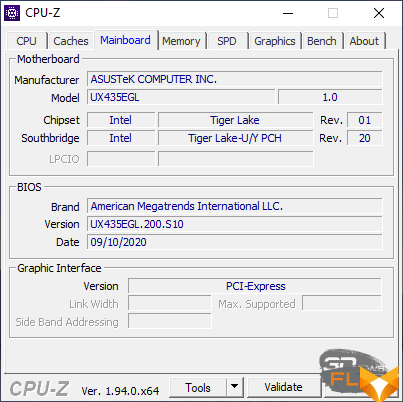
Already during the tests, we updated the BIOS to the latest available version – 204, dated November 10, 2020.
ASUS ZenBook 14 Ultralight UX435EGL can be equipped with one of two 11th generation Tiger Lake-U family processors: Intel Core i5-1135G7 or Intel Core i7-1165G7. Our version of the ultrabook has just the latest version of the processor.
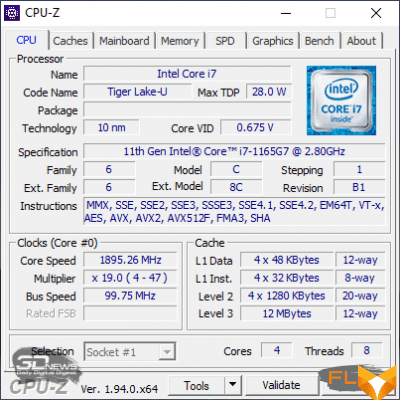 |
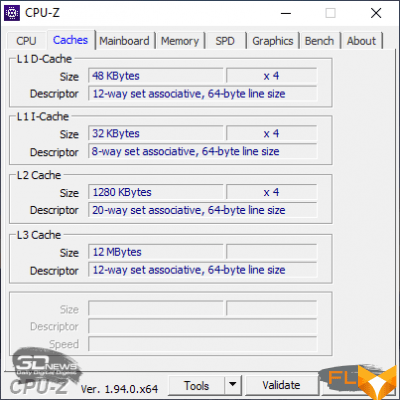 |
Recall that such a CPU, depending on the type of load, can operate at frequencies from 1.2 to 4.7 GHz. It has 12MB of L3 cache, its maximum TDP is 28W, and its base is more than half that of 12W.
The ultrabook can be equipped with 8 or 16 GB of LPDDR4X RAM soldered on the motherboard. There is no 32 GB version, just as there is no possibility to increase the volume. But its effective frequency is very high 4266 MHz, albeit with timings of 36-39-39-90_1T.
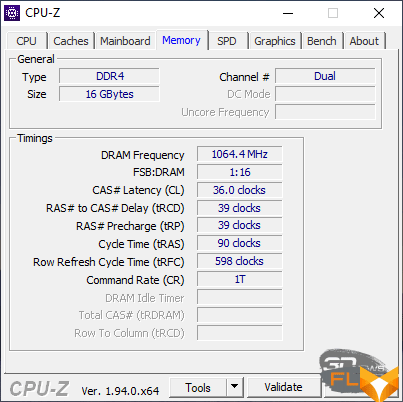
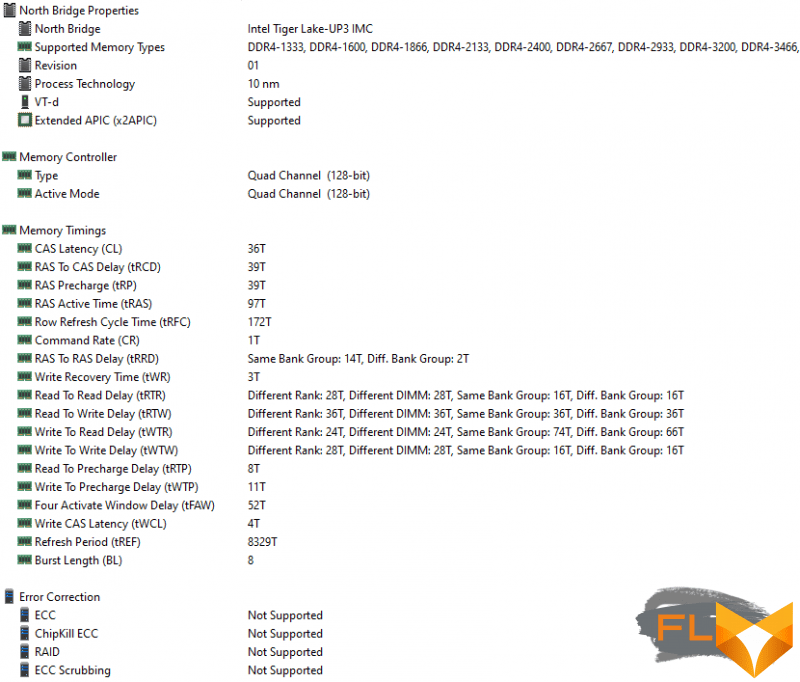
Unlike the ASUS ZenBook Flip S UX371EA model we recently tested, the ZenBook 14 Ultralight UX435EGL has the ability to use not only the Intel Iris Xe graphics core built into the processor, but also an optional NVIDIA GeForce MX450 discrete graphics card.
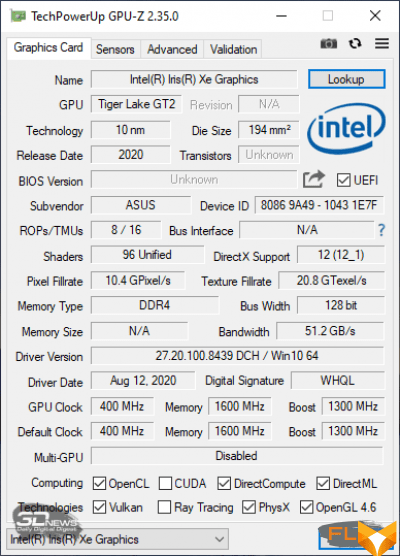 |
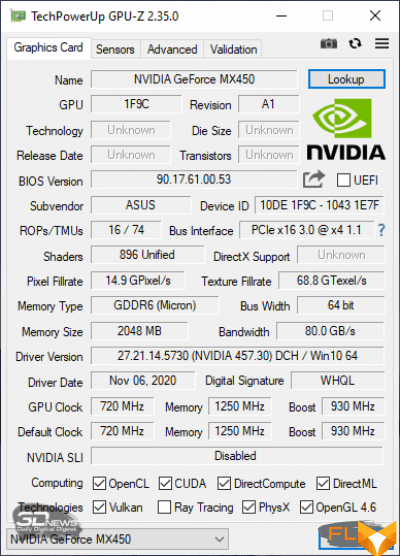 |
GeForce MX450 —this is a new video card that differs from its predecessor MX350 in that it is produced using a 12nm process technology, has 896 shader processors (+40%) and 10 GHz GDDR6 memory (+43%), as well as slightly higher core frequency. The remaining characteristics of these video cards are almost the same, but even the above allowed the GeForce MX450 to outperform its predecessor by 33%, and the Intel Iris Xe graphics core built into the processor – 2.5 times at once. Nevertheless, counting on a stable 60 FPS in current games, as you understand, is not oit.
In ASUS ZenBook 14 Ultralight UX435EGL, you can find only one SSD drive – 256 GB, 512 GB or 1 TB. At the same time, there are versions where one of the two larger drives is combined with 32 GB of Intel Optane H10 memory. Our version of the ultrabook has an Intel P660 SSD (SSDPEKNW010T8) with a capacity of 1 TB and a claimed resource of 200 TBW.
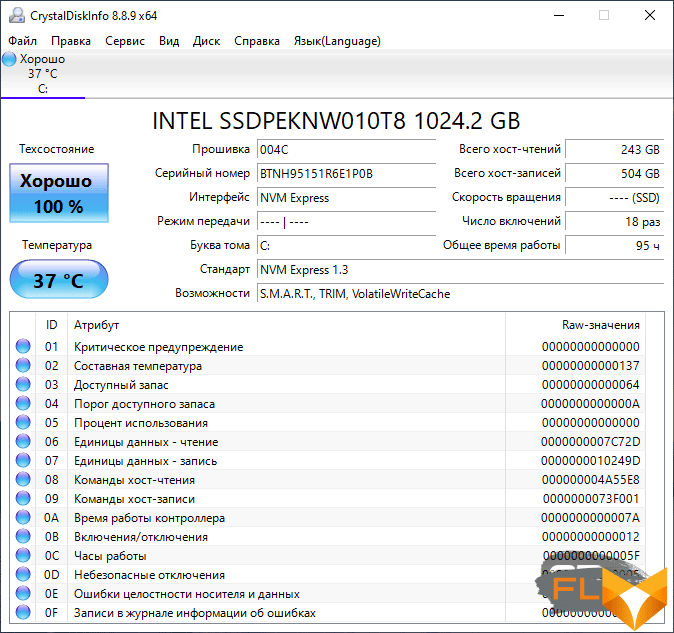
The performance of such a drive is average by today’s standards, but it is minimally dependent on the operating mode of the ultrabook, whether it is connected to a power adapter and the mains (the results on the left) or operates exclusively from the built-in battery (the results on the right).
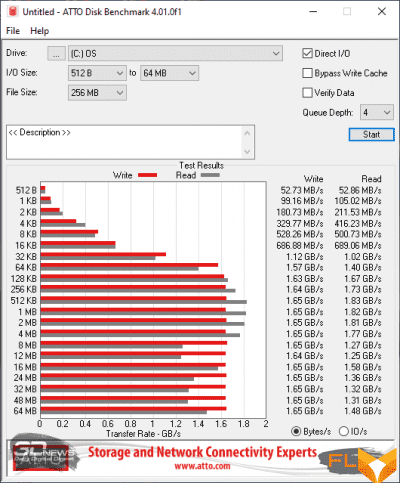 |
 |
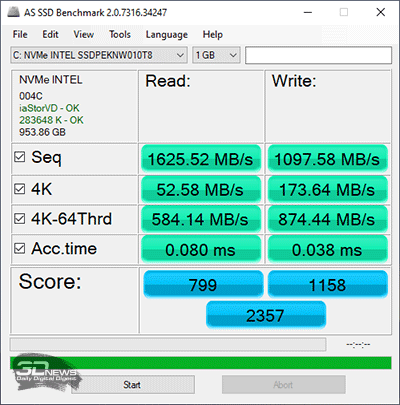 |
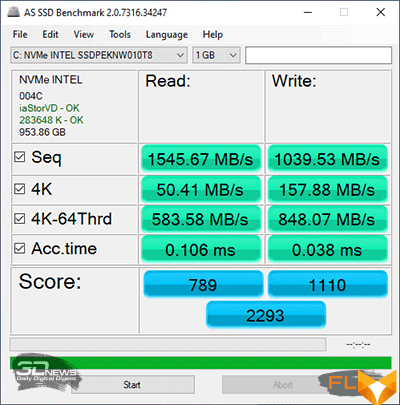 |
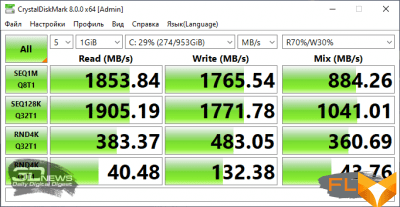 |
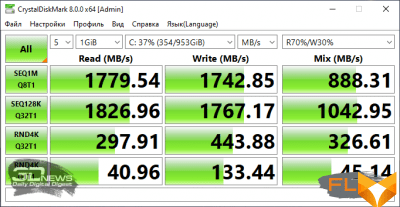 |
At the same time, in everyday work, the drive does not heat up above 35 degrees Celsius, and even in the stress test, the SSD showed a maximum of 45 degrees Celsius (lower monitoring graph), which cannot be said about the central processor, the temperature regime of which we check it out.
SSD stress test on AC power
Network connections in the ASUS ZenBook 14 Ultralight UX435EGL are provided by the Intel AX201D2W wireless module with Wi-Fi 6 (802.11ax), MIMO 2 × 2, and the ability to operate at frequencies of 2.5 and 5.0 GHz (160 MHz bandwidth). Two antennas of the wireless module are displayed on the sides of the ultrabook case.
The sound system here is typical for the ZenBook series. Harman Kardon specialists participated in its development, which is noted right on the ultrabook case.

There are two speakers here, they are built into the trapezoidal sections of the front part of the base of the case.
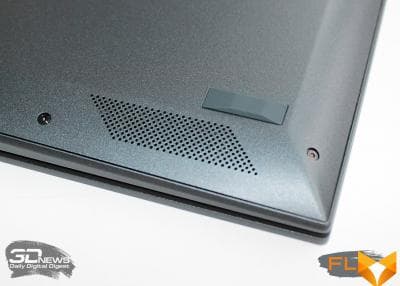 |
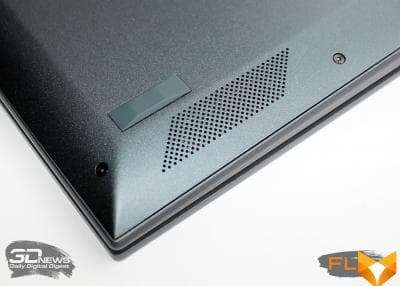 |
Speakers have enough headroom for a room of 18-20 square meters, while nothing rattles or vibrates. High and mid frequencies are reproduced clearly and loudly, and for obvious reasons there are very few low frequencies, but it cannot be said that they are completely absent.
⇡#Cooling system, efficiency and noise level
The ultrabook’s cooling system uses one fan, heat sink and one heat pipe. Cold air is sucked in by the fan from below through the ventilation grill at the base, and the heated air is ejected through the rear end, straight to the display.

ASUS assured us that such heating will not harm the display at all. The cooling system is adjusted in such a way that even at the maximum fan speed, working with an ultrabook cannot be called uncomfortable – noise is heard, but does not interfere. In modes without load on the central processor and video card, the ultrabook runs silently. As with other ASUS ultrabooks, fan settings are controlled in the Fan Profile section of the My ASUS app.
To evaluate the efficiency of CPU cooling in the ultrabook, we used the powerMAX utility (in AVX mode), and the monitoring parameters were read and displayed by HWiNFO64. Testing was conducted at an indoor temperature of approximately 24.5 degrees Celsius running the operating system Windows 10 Pro x64 with the latest available drivers and updates.
We checked the temperature regime of ASUS ZenBook 14 Ultralight UX435EGL when the ultrabook was powered from the mains and from the battery, obtaining the following results.
|
Powered by mains |
Battery powered |
Comparing both results, we can immediately say that there are no cardinal differences in the operation of the ultrabook in different modes, which are observed in more productive models. In the first case, when connected to a power adapter, the ASUS ZenBook 14 Ultralight UX435EGL processor, after temperature stabilization, operates at a frequency of 2.3 GHz at a TDP level of about 20 watts and a temperature above 90 degrees Celsius. In the second, when powered by battery, the average processor frequency in the load is even 0.1 GHz higher at a slightly higher TDP – 23 W – and, ultimately, lower temperatures. But the latter are the merit of the activated cooling system fan, which was silent during the entire stress test from the mains. In general, it can be summarized that for this ultrabook model there is practically no difference in which mode it works (mains/battery).
With a similar test of the video card with the Fire Strike stability test from the 3DMark package, we got identical results at all.
|
Powered by mains |
Battery powered |
In both operating modes of the ultrabook, the graphics processor of the discrete video card ran at a frequency slightly above 1.1 GHz, the effective frequency of the video memory was 10 GHz, and the GPU temperature rose only to 67-68 degrees Celsius.
Based on the stress tests of the CPU and discrete graphics card of the ASUS ZenBook 14 Ultralight UX435EGL ultrabook, we can conclude that its performance should not depend on the connection to the power adapter or battery operation. Next, we will confirm this with test results.
Performance testing
So, the test results of ASUS ZenBook 14 Ultralight UX435EGL when working from the power adapter and the mains are shown on the left, and when working on battery – on the right.
|
AIDA64 Extreme memory and GPGPU test (power grid) |
AIDA64 Extreme memory and GPGPU test (battery) |
|
WinRAR (power grid) |
WinRAR (battery) |
|
7-Zip (power grid) |
7-Zip (battery) |

HandBrake (grid) |
HandBrake (battery) |
|
Cinebench R20 (power grid) |
Cinebench R20 (battery) |
|
Cinebench R23 (power grid) |
Cinebench R23 (battery) |
|
Blender 2.90 classroom (power grid) |
Blender 2.90 classroom (battery) |
|
Geekbench 5 (power grid) |
Geekbench 5 (battery) |
|
PCMark’10 (power grid) |
PCMark’10 (Battery) |
|
CompuBench 2.0 (power grid) |
CompuBench 2.0 (battery) |
 |
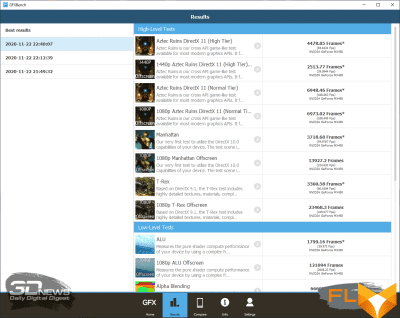 |
|
GFXBench 5 (power grid) |
GFXBench 5 (Battery) |
|
3DMark Night Raid (power grid) |
3DMark Night Raid (Battery) |
|
3DMark Fire Strike (power grid) |
3DMark Fire Strike (Battery) |
|
3DMark Wild Life (power grid) |
3DMark Wild Life (Battery) |
|
World of Tanks enCore RT (power grid) |
World of Tanks enCore RT (battery) |
|
World War Z (power grid) |
World War Z (battery) |
The difference is still there, the ultrabook runs a little faster when connected to the mains, but a lot depends on the specific test. Somewhere this difference can reach 15%, and somewhere it does not exist at all. The biggest difference can be felt in games.
In our opinion, in terms of performance, ASUS ZenBook 14 Ultralight UX435EGL will be interesting to compare with ASUS ZenBook Flip S UX371EA, which has almost the same hardware configuration, except for the absence of a discrete NVIDIA GeForce MX450. Processors and memory in these ultrabooks are identical to each other. We present the results in the table.
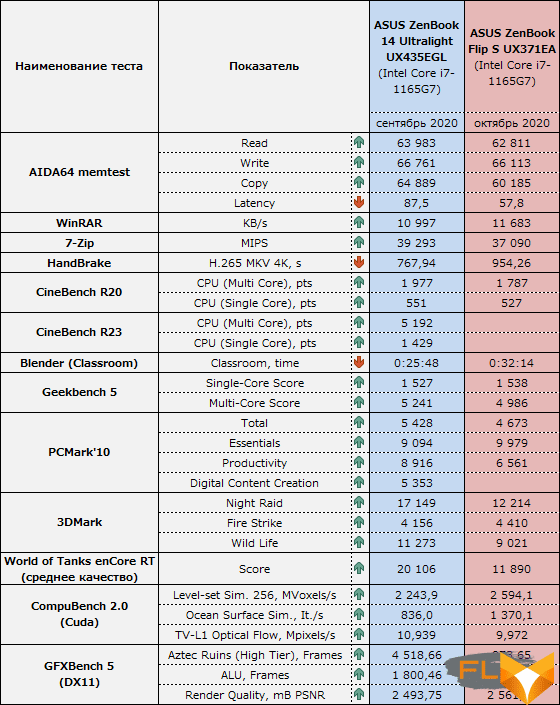
Interestingly, the ZenBook 14 Ultralight UX435EGL turned out to be slightly faster than its counterpart in the processor and memory benchmarks, but in some of them (WinRAR or CompuBench) the premium ZenBook Flip S UX371EA is slightly ahead. In games, for obvious reasons, the hero of today’s material is in the lead. The GeForce MX450, of course, can hardly be called a gaming video card, but compared to the graphics integrated into the processor, this is a significant increase in performance.
⇡#Autonomous
The ultrabook comes with a compact and lightweight (225 g) AD2129320 65 W (20.0 V, 3.25 A) power adapter. The adapter has a built-in 1.95 meter cable.
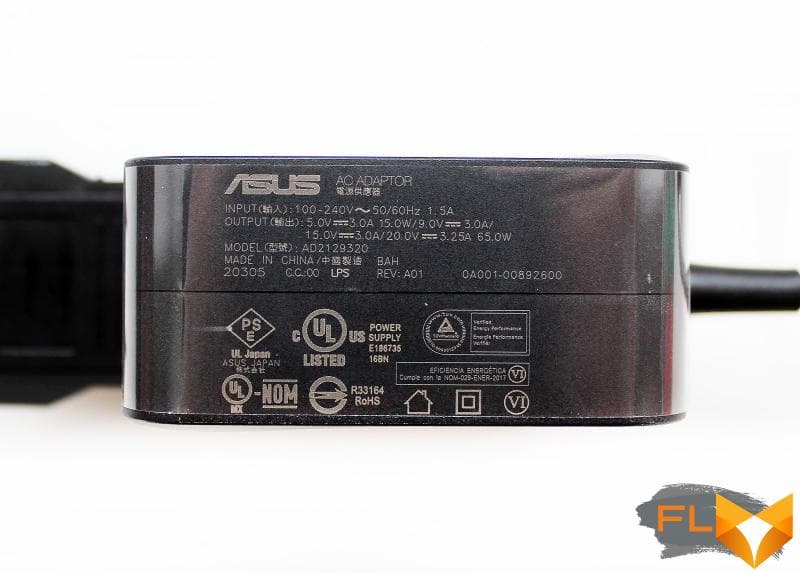
The capacity of the lithium-polymer battery in the ultrabook is 63 Wh.
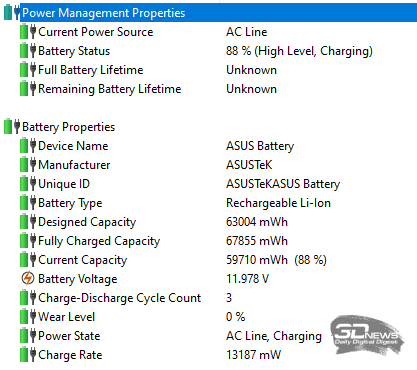
The time to fully charge the battery turned out to be relatively long. We observed at least four cycles of almost full charge – from 3 to 99%, and the average charge time was 2 hours 35 minutes.
We tested the battery life of the new ZenBook 14 Ultralight UX435EGL in PCMark’10 using Modern Office, Applications, Gaming and Video testing modes with the display brightness manually fixed at 200 cd/m 2. The results are shown in the screenshots.
|
PCMark’10 “Modern Office” (15h1m) |
PCMark’10 “Applications” (16h10) |
|
PCMark’10 “Gaming” (2 hours 5 minutes) |
PCMark’10 “Video” (15h11) |
Well, this is no longer science fiction, but impressive performance without reservation. The battery of the ultrabook will last at least 15-16 hours of continuous work in office applications or when playing full-screen Full HD video, and you can play on it for at least two hours, and there will be no performance drop that is usually observed in gaming laptop models.
⇡#Conclusion
If you need a light, compact and at the same time productive ultrabook with a high-quality display and fifteen hours of battery life, then the ASUS ZenBook 14 Ultralight UX435EGL can be considered the first and so far almost the only such ultrabook that combines all these qualities at the same time. In addition, this model is equipped with a discrete graphics card, which allows you to spend a couple of hours playing some not too resource-intensive toys with medium graphics quality settings. At the same time, it is important that the ZenBook 14 Ultralight UX435EGL does not experience a multiple drop in performance when running on battery power – both in computing and in gaming tasks it maintains a level sufficient for comfortable work.
Separately, we note the perfectly calibrated IPS display at the factory, the Thunderbolt 4 interface, the convenient NumberPad 2.0 and the wireless communication module with Wi-Fi 6 support. Among the shortcomings are small arrows on the keyboard, and, perhaps, that’s all. What will happen to the cost of top-end configurations – we will find out over time, but it is already clear that in such a format and with such characteristics there will be no affordable price for ASUS ZenBook 14 Ultralight UX435EGL.
FAQ Asus zenbook 14 ultralight ux435egl
What distinguishes the 11th Gen Intel processors in the ASUS ZenBook 14 UX435?
The 11th Gen Intel processors in the ASUS ZenBook 14 UX435 combine superb performance and effortless portability, making it ideal for on-the-go productivity and entertainment.
How does the ZenBook 14 UX435 maintain its portability?
The ZenBook 14 UX435 maintains its portability with timeless good looks and a lightweight design, weighing as little as possible while still providing great battery life and robust performance.
What are the advantages of the microSD card reader in the ZenBook 14 series?
The microSD card reader in the ZenBook 14 series, like the UX435, allows for easy expansion of storage and convenient transfer of photos and files from various devices.
What type of USB ports are available on the ASUS ZenBook 14?
The ASUS ZenBook 14 includes USB 3.2 Gen 1 ports, offering fast data transfer speeds and broad compatibility with a range of peripherals and devices.
How does the ASUS NumberPad 2.0 enhance the functionality of the ZenBook 14?
The ASUS NumberPad 2.0 on the ZenBook 14 allows for a more efficient and convenient way to input numbers, ideal for professionals and students who frequently work with numerical data.
What makes the ZenBook 14 UX435EAL suitable for color-sensitive work?
The ZenBook 14 UX435EAL’s display covers a wide sRGB color gamut, ensuring vivid and accurate color reproduction, making it suitable for color-sensitive work like graphic design and photo editing.
What are the key features of the ZenBook 14 UX425?
The ZenBook 14 UX425 features a frameless four-sided NanoEdge display, a precision-engineered ErgoLift hinge that tilts the rear of the laptop slightly for better typing comfort, and includes a collection of handy ASUS apps and tools.
Can the ZenBook 14 Ultralight handle demanding applications?
The ZenBook 14 Ultralight is powered by the latest processors, enabling it to handle demanding applications with ease, combining performance with portability.
How does the ZenBook 14 UX434 facilitate a seamless laptop experience?
The ZenBook 14 UX434 facilitates a seamless experience by featuring a frameless four-sided NanoEdge wide-view display, ensuring immersive visuals, and it also includes ASUS’s collection of productivity-enhancing apps.
What charging options are available for the ZenBook 14?
The ZenBook 14 can be charged using a certified USB Power Delivery charger, allowing the laptop to connect seamlessly and charge quickly, making it convenient for users on the move.
What operating system does ASUS recommend for the ZenBook Pro?
ASUS recommends Windows 10 Pro for the ZenBook Pro, offering advanced features and enhanced security for professional use.
Does the ZenBook 14 Ultralight come with Windows 11 Pro or Windows 11 Home?
The ZenBook 14 Ultralight offers options for both Windows 11 Pro and Windows 11 Home, catering to different user preferences and needs.
What is the screen size of the UX435 in the ZenBook series?
The UX435 in the ASUS ZenBook series features a 14-inch display, providing a balance between portability and comfortable viewing.
How can users access service and support for their ZenBook 13 UX325?
Users can access service and support for the ZenBook 13 UX325 through the “Manuals check repair status MyASUS” feature or by contacting their local ASUS representative for assistance.
What makes the ZenBook 14 Ultralight suitable for portable use?
The ZenBook 14 Ultralight’s design emphasizes effortless portability with timeless good looks, combining a lightweight build with powerful performance.
What unique feature does the ZenBook 14 have for ergonomic typing?
The ZenBook 14 has a precision-engineered ErgoLift hinge that slightly tilts the keyboard for a more comfortable typing experience.
How does ASUS ensure seamless connectivity in its laptops like the ZenBook 14?
ASUS ensures that laptops like the ZenBook 14 connect seamlessly with various devices and networks, often including features like fast Wi-Fi and a range of ports for easy connectivity.
Can users charge the ZenBook 15 UX534 with any charger?
For the best results and safety, users should charge the ZenBook 15 UX534 with a certified charger compatible with the laptop’s charging specifications.
Where can users find more information about different ZenBook models?
Users can find more information about different ZenBook models on the ASUS website or by checking with their local ASUS representative for specific details and availability.
How does the display brightness of the ZenBook series enhance the user experience?
The display brightness in the ZenBook series, often set to around 150 nits for standard use, provides clear and comfortable visibility, enhancing the overall user experience for both work and entertainment.


